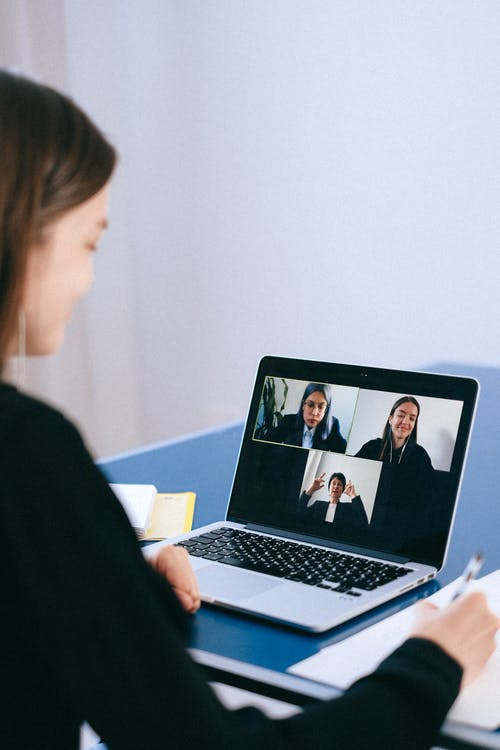I’m trying to be completely honest — I’m tired of writing, discussing, and thinking about working from home probably because most of us have been back in the office for months. The vaccine has made all of us feel a lot safer and we are grateful for that. However, despite the vaccine — many of our employees, and even management continue to need hybrid solutions to work from home when they want to do so.
It’s been found that nine months into the pandemic, 41.8% of the American workforce remains fully remote. And, managers are anticipating that this will continue. In fact, they believe that 26.7% of the workforce will be fully remote in another year.
Clearly, WFH isn’t going anywhere, anytime soon — at least not this year. As such, it’s still necessary to talk about how to remain engaged and productive while working virtually.
But, here’s the issue. We’ve heard the same advice over and over again. You know what I’m saying? Have a routine, get dressed, set boundaries, yadda, yadda.
Moreover, these WFH hacks are approached as a one-size-fits-all approach — but are they?
Not everyone has a home office. Parents can’t always work when they’re most productive. And, how can we focus on work when COVID has taken such a toll on how mental health and wellbeing?
These are all lessons that we’ve learned about working from home through the last year and a half. As we continue to try and find where the real balance in work will be — here are 10 realistic and unconventional tips you can try for the next year and a half.
1. Biohack your way to peak productivity.
According to performance expert, New York Times bestselling author, and founder and executive director of the Flow Research Collective Steven Kotler, you need to take a physical and cognitive approach if you want to enhance your productivity. “If you’re interested in peak performance, you have to be doing these things,” he says. “Otherwise you can’t even get into the game.”
How can you accomplish this? Kotler advises that you focus on the five following non-negotiables:
- Get seven to eight hours of sleep each night. If possible, maintain a consistent schedule that’s based on your circadian rhythms.
- Find social support to counter loneliness. Additionally, being surrounded by high-quality connections has the ability to lift your spirits.
- Manage your anxiety levels. “Anxiety is a huge break on people,” says Kotler. Gratitude, mindfulness, and exercise can all help.
- Set tangible, specific, and process-oriented goals. A long-term goal, like I want to be the greatest author in history, won’t stick. “That’s a moving target. It’s an aim,” says Kotler. “You want to chunk those down into hard, one to five-year goals.” Instead, try; I’d like to write a New York Times bestseller.
- Discover your intrinsic motivations. “There are five major intrinsic motivators that matter,” says Kotler. Curiosity, purpose, autonomy, purpose, and mastery. They’re all aligned and cannot thrive without the other.
“When we screw up peak performance, it’s nothing more than getting our biology to work for us rather than against us,” says Kotler.
2. Create a “zen” zone.
“No matter where you work — the dining room table or a dedicated home office — it’s essential to create an environment that helps you focus,” says Marie Kondo.
“Clutter overwhelms the brain and compromises the ability to take initiative; a calm and clean area will enhance both productivity and joy,” she adds. How can you get there? Kondo recommends identifying “the items that are crucial to getting your work done” and designating them a home.
“If you don’t have an office, a box or portable carrier will do,” Kondo adds. “Move all unrelated items off of your workspace and add one thing that sparks joy when you look at it.” For her, “it’s a crystal and small vase of fresh flowers on my desk.”
If space is an issue, you can find some inspiration from IKEA’s 2021 Catalog. Some ideas include using the IVAR storage combination as a room divider or a NISSAFORS cart to hold supplies.
3. Embrace mono-tasking.
Is it possible to have a conversation with a friend while doing household chores? Absolutely. But, can that’s probably not a good idea when it comes to tasks that are more challenging, such as deep work. Even if you believe you’re a pro at this, then you’re in the minority — only 2% are actually capable of this.
So, instead of trying to do the impossible, embrace mono-tasking.
“We’ve been sold the myth that multi-tasking is a valuable skill, giving us the ability to get it all done – but this couldn’t be further from the truth,” explains business coach Ryan Jackson, author of The Success Rebellion.
“A more productive approach is to devote days or half-days to themes, or closely related tasks,” he adds. “That way, it’s easier to knock jobs down one at a time and even if you do get distracted, it’s quicker to pick up the thread again.”
4. Take a shower in the middle of the day.
It’s been regularly suggested that taking a shower, or bath, should be a part of your morning or evening routine. However, if you’re dragging, take a shower in the middle of the day. Seriously.
“The relaxing, solitary, and non-judgmental shower environment may afford creative thinking by allowing the mind to wander freely,” said Ron Friedman, Ph.D., founder of Ignite80, during a 2016 online summit. In turn, this lets “people to be more open to their inner stream of consciousness and daydreams.”
5. Do household chores when you’re stuck.
“Whenever you are hitting a wall on trying to brainstorm ideas or solve a certain problem, turn to simple, undemanding, household chores like washing dishes,” recommends Nick Rizzo, Fitness Research Director at RunRepeat. “That’s because studies have shown that engaging in undemanding tasks significantly boosts performance and creative problem-solving when compared to switching to a different demanding task or taking a break.”
“While your brain is mildly focused on the undemanding task, your mind wanders and expands up its problem-solving capacity,” he adds. I can attest that this is 100% true. Other household chores that have helped me get unstuck are folding the laundry, prepping meals, and light cleaning like wiping down the kitchen counter.
6. Straddle the line between comfort and class.
I get it. Changing out of your pajamas into clothes that you would wear to the office can help you transition into work mode. But, why bother when comfort is ket right now?
Instead, find a balance between the two. For instance, you could wear your cozy, broken-in jeans with a semi-casual button-down, henley, or sweater. If you need some ideas, here are some suggestions from Vogue and Men’s Health.
7. Avoid (COVID) decision fatigue.
“35,000. That’s one estimate on how many decisions we make each day,” writes Calendar co-founder John Hall. “And, if true, that would come out to around 2,000 decisions per hour or one decision every two seconds.”
“Even if you don’t believe those exact numbers, the truth is that we do make a lot of decisions on a daily basis,” he adds. And, in the midst of COVID, the number of decisions we have to make has increased.
“People working and schooling from home have had to figure out where everyone is going to do their work, what times are best and worst for focused work, when to take breaks, and how to eat lunch without disrupting others,” clarifies Kathleen Vohs, Ph.D., Distinguished McKnight University Professor at the University of Minnesota, and a behavioral scientist who worked on early research about decision fatigue. “The lack of a routine in such a big part of our lives — the period from 8 am to 4 pm — has created a whole host of new decisions.”
What can be done about this?
Simplifying your life is an excellent starting point. “For example, on Sundays prep your meals for the week,” suggests Hall. “Go through your closet and donate the clothes that you no longer wear. And, remove unnecessary events and tasks from your calendar.”
Moreover, automate as much as you can, such as eating the same breakfast every morning. You can also lower your expectations. “Things don’t have to be perfect right now, and maintaining mental health is worth wearing the same jewelry in every Zoom call,” Dr. Vohs says.
And, you can also make upfront decisions with those around you. “Whoever is in your network — roommates, family, friends — it’s worthwhile to spend some time talking through decisions together.” When you do, “you can figure out what are priorities” and “where you’re willing to take risks.”
8. Fight back against loneliness.
“Remember we’re social animals,” says Dr. Angela Carter, an associate fellow at the British Psychological Society. “Part of the reason we go to work is that we love being with other people.” And, this has been one of the greatest challenges we’ve had to overcome in 2020.
Weekly video calls are a start. But, a lot of the interaction that takes place in the workplace is non-work related. As such, schedule virtual coffee breaks, lunches, and off-hour events.
Additionally, make sure to keep in touch with family and friends during your downtime. I know that we’re all experiencing Zoom fatigue. But, it’s still essential for our health and wellbeing.
9. Adopt a “Blue Zone” approach to exercise.
As you’re well aware, exercise is essential. Besides being key to your physical health, working out is beneficial to your mental wellbeing and productivity. And, this is particularly true during COVID.
However, it’s been impossible to maintain a regular exercise regiment this year. As such, you may need to be more flexible. The folks over at Well + Good have dubbed this as “Blue Zones.”
In a nutshell, these are mini-workouts that you squeeze in throughout the day. Examples include walking your dog, biking to the store, or stretching before a Zoom call. Overall, it’s all about incorporating some sort of physical activity into your daily routine.
10. Cut everyone some slack (including yourself).
“It’s not realistic to expect full productivity while people are juggling working from home, extra family and household responsibilities, for many, and managing pervasive stress and anxiety for just about everyone,” says Joshua Zerkel, head of global community for the work management platform Asana. “It’s a lot, and we need to remember that we are humans and not productivity machines.”
However, “we can still be productive and connected,” he adds. “It just looks different than when we’re sitting with our coworkers at the office.”
Rather than beating yourself up, forgive yourself and those around you. “We’re all doing the best we can,” says Dr. Jennifer Goldman-Wetzler, organizational psychologist and author of Optimal Outcomes: Free Yourself from Conflict at Work, at Home, and in Life. “The silver lining to me of this whole crisis is that when we come out of it, those of us who’ve been perfectionists are learning how to let that go. Learn how to set expectations but also let go of those things that don’t serve you well.”










